
Original Link: https://www.anandtech.com/show/1464
NVIDIA GeForce 6600 GT: Bringing NV4x to the Masses
by Derek Wilson on September 7, 2004 9:00 AM EST- Posted in
- GPUs
Introduction
Until now, we haven't had the pleasure of playing with a midrange part based on current generation technology. At present, those who have wanted good performance at lower prices have gone with older cards that have fallen in price. This is all well and good, but consumers lose out on all the new and improved features of the latest architectures when buying high end cards of a previous generation over the midrange cards built with current technology. This is especially pertinent in light of NVIDIA's Shader Model 3.0 support. Generally, anything that can be done in SM3.0 can be done in SM2.0, but the advantage is code complexity and (sometimes) performance improvements. We've already seen examples of this in our SM3.0 analysis under FarCry.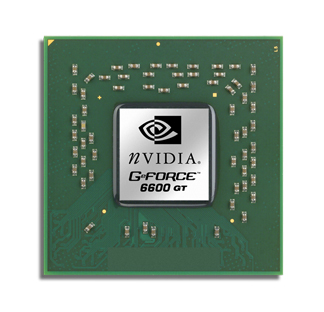
The NV43 GPU behind the 6600 GT
Also with the new 6600 line of cards, NVIDIA is bringing out their first native PCIe line of GPUs. These should quickly be bridged back to AGP (we are told), and the sooner we see the AGP version the better. Even if PCI Express platform market share were better right now, the niche the 6600 series of cards proposes to fill is one that could appeal to everyone who uses a computer. The keys behind the 6600 series (aside from feature set) are performance and price point. All of the aspects of the 6600 series fall in line to offer a card that promises amazing value.
But we don't care about promises here. We will take a handful of the latest and greatest games across the spectrum (with a heavy focus on PS2.0), and we'll see how well the newest member of the NVIDIA family performs. As far as competition goes, we'll stack it up against current and previous generation ATI and NVIDIA cards and we'll include ATI's current midrange PCIe card, the X600XT. This isn't supposed to be a direct comparison, as the X600 is still based on previous generations ATI technology. We will make a bigger deal of the ATI/NVIDIA comparison when we have a midrange R4xx desktop part in our hands.
High-Tech Mid-Range
The 6600 series of GPUs (NV43) are based on the NV40 core architecture. The entire feature set from the 6800 line is carried over with only a few exceptions. First, the memory bandwidth of the card is cut from 256 down to 128. This should have a fairly large impact on AA/AF performance and other very graphics memory intensive operations. The second adjustment NVIDIA includes in NV43 is a reduction in the maximum number of supported pixel pipelines. 6600 series cards have 8 pixel pipelines. This is half the max of the NV40 core.Of course, we can also look at NV43 as the same number of pipelines as a 9800XT, and twice the pipelines in a 5950 Ultra. This, and the 500 core and 500 memory clock speeds, make the 6600 GT a very formidable contender on paper. For anyone interested, AnandTech has recently published an article detailing the theoretical maximums (among other things) of just about every ATI and NVIDIA card since Radeon and GeForce were first introduced. Higher theoretical fill rates and processing power are always nice things to see, but can the card deliver?
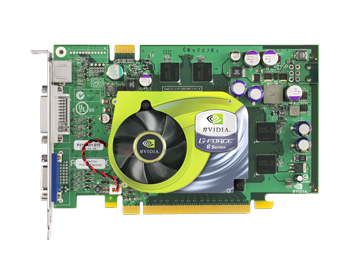
The 6600 GT also features one of the most exciting aspects of the NV4x series of GPUs: SLI. We've covered NVIDIA's take on SLI before, and we are happy to see it making its way down the line of NV GPUs. Obviously, one would not get the same power from 2x $200 cards than from 2x $500 cards, but dropping the price on an SLI capable card is really opening the door to those who would like to see some sort of upgradeability maintained in today's ever changing scene.
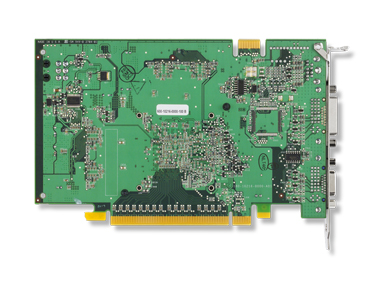
We haven't yet gotten our hands on a regular 6600, but traditionally, the $200 parts have been the sweet spot for price/performance ratios. That's not to say that the 6600 won't be a good deal, but NVIDIA will have to be careful to push clock speeds that don't offer a (much?) lower value. We would have dropped the clock on our 6600 GT to match 6600 speeds, but they use different memory types. We'll have to wait until we can get our hands on one of those to see some performance numbers.
It is worth mentioning that neither the 6600 nor the 6600 GT require an external power source. That isn't to say that they are less power hungry than an AGP card that requires external power, but that the PCI Express slot supplies enough voltage to the card that it doesn't need any more juice. PCI Express is designed to be more robust in that area than AGP.
There's not much else to say other than to reiterate that the 6600 series sport the same feature set (barring the exceptions mentioned) as the original NV40 GPUs. So, without further ado, we present the benchmarks.
The Test
As of yet, ATI does not have a comparable part to the 6600 or the 6600 GT. They are working on bringing an R4xx based midrange chip out at some point in the future, but we haven't gotten any concrete details about possible parts yet. For this review, we took a look at the X600 XT as a comparison point, but as it turns out, this isn't as helpful as we had hoped. The major problem is that we wanted a good comparison with current and previous generation GPUs, and the only way we could effectively do that was by comparing AGP cards to these PCI Express solutions. As such, most of the numbers other than the 6600 GT and the X600 XT have been run on our 3400+ graphics system. The Doom 3 and Source Engine AGP benchmarks were run on the overclocked FX53, and so aren't as comparable to the rest of the world.But we feel that this is an acceptable setup in light of the fact that PCI Express systems will have to compete with AGP systems. Our graphics test platform is based on AMD, and this serves us well enough in simply comparing how well the 6600 does in modern games (which are mostly graphics limited anyway). As long as the processor is powerful enough to keep from becoming a large bottleneck we will have a clue about NV43 performance. And we feel we've accomplished this. Here's our test setup.
Performance Test Configuration |
|
Processor(s): |
AMD Athlon 64 3400+ |
RAM: |
2 x 512Mb OCZ 3500 Platinum Ltd (2:3: 2:10) |
Hard Drives |
Seagate 120GB 7200 RPM (8MB Buffer) |
Video AGP & IDE Bus Master Drivers |
VIA Hyperion 4.51 |
Video Card(s): |
NVIDIA GeForce 6600 GT |
Video Drivers: |
ATI Catalyst 4.6 |
Operating System(s): |
Windows XP Professional SP2 |
Motherboards: |
MSI MS-6702E (VIA K8T800 Pro Chipset) |
The 61.77 drivers were used on all but the 6600 GT, which was powered by the 65.37 beta drivers. On the ATI side, most of the numbers shown here were run with the 4.6 Catalyst, except the X600 XT which was run with the 4.8 version.
Aquamark 3 Performance
The 6600 GT posts a very nice score in a dead heat with the GeForce 6800 and Radeon X800 Pro. The Aquamark 3 benchmark is sensitive to CPU speed, and the 6600 GT score may be a little higher than it should due to the fact that its running on a P4 3.4 EE rather than the 3400+ behind the more poewrful cards. At the same time, this benchmark is mostly GPU limited and it is very impressive to see a midrange card score over 50 no matter what CPU it's running on.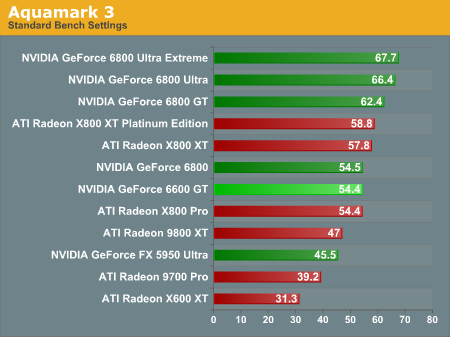
Doom 3 Performance
Considering that the 3400+ outperformed the 3.4 EE in our Doom 3 CPU Battleground article, its very impressive that the 6600 GT scores this high in the PCIe system. The score falls in comparison to more powerful cards as resolution is increased past 1024x768 and AA is turned on. These resolutions are lower than other tests because Doom 3 is such a taxing game.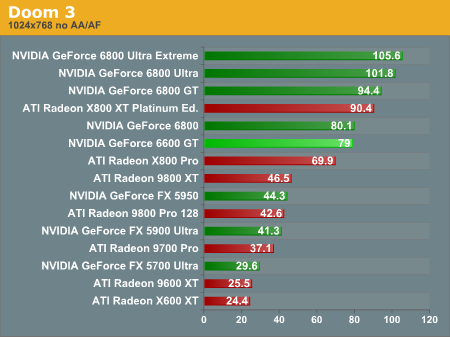
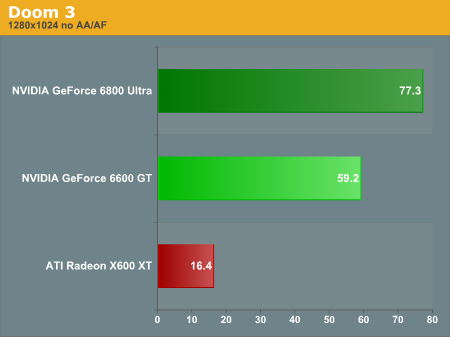
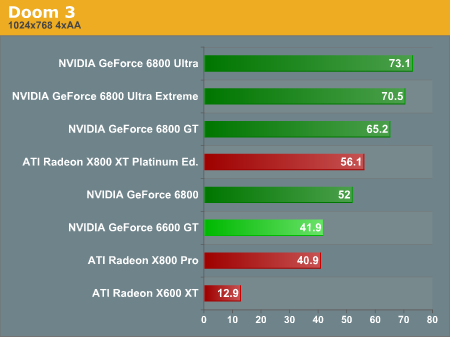

FarCry Performance
The 6600 GT stays playable upto 1600x1200 without AA/AF. The card really doesn't like turning on AA under FarCry -- doing so incurrs a large performance hit. Even so, at the highest settings we tested, the 6600 GT still beat the 5950 Ultra.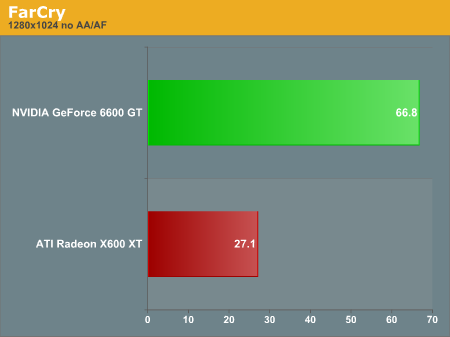
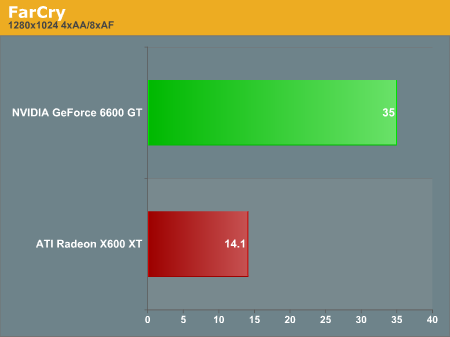
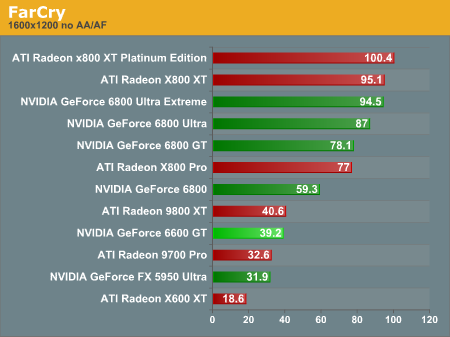
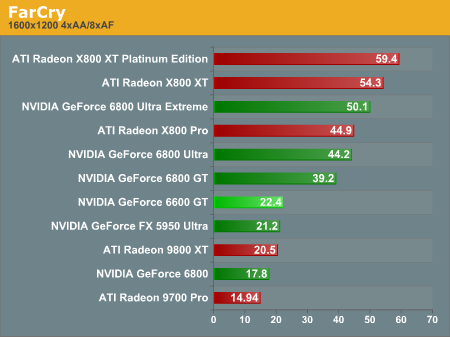
Halo Performance
At either resolution, the GeForce 6600 GT sticks between the 6800 and the X800 Pro. The X600 XT had issues running the halo benchmark that we couldn't track down before publication.
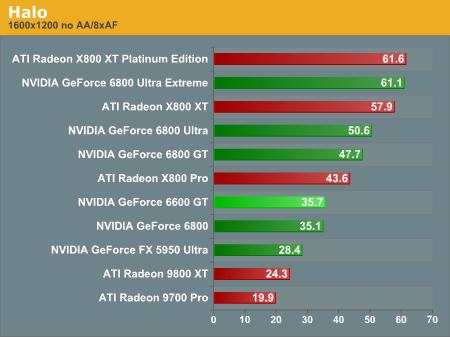
Jedi Knight: Jedi Academy Performance
Under this OpenGL game, the 6600 starts out very strong and puts in a good showing until AA and AF are enabled.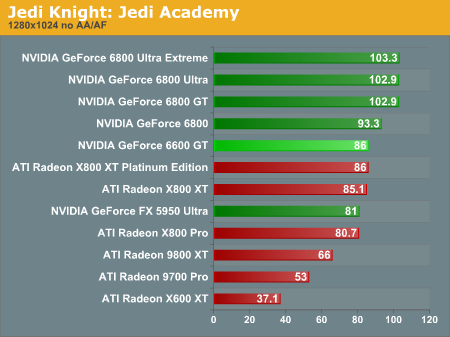
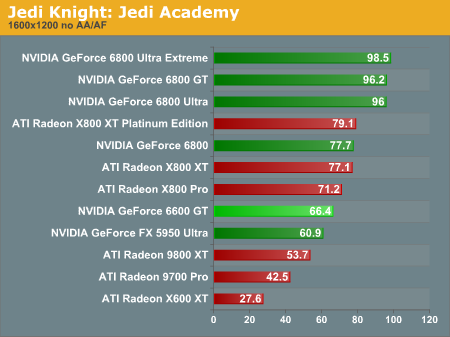
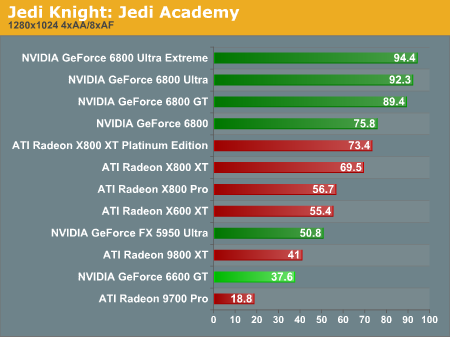
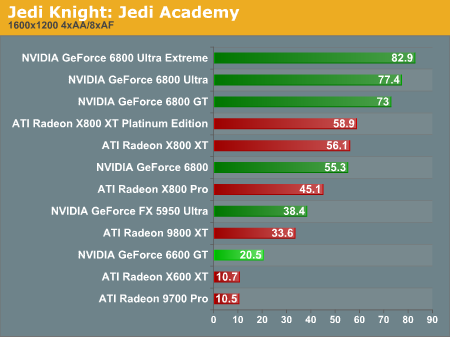
Source Engine Stress Test
This test shows that the GeForce 6600 GT is prefectly capable of filling the gap between last generation's top of the line, and this generation's lower performing high end cards.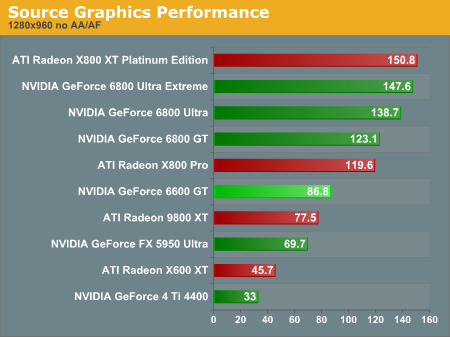
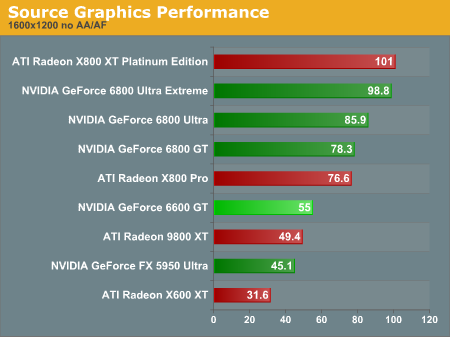
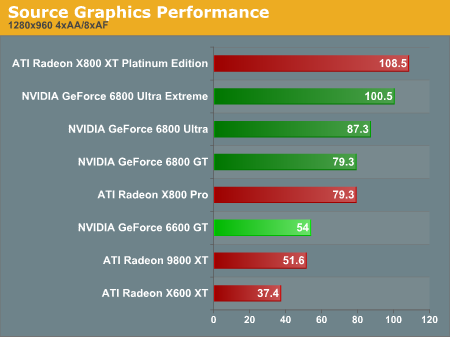
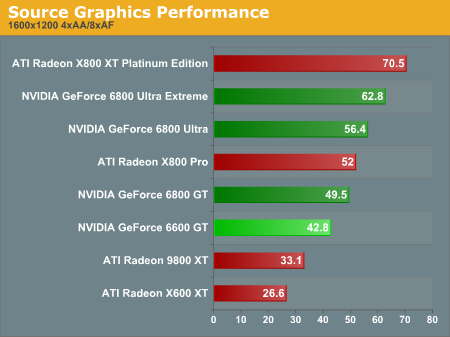
Unreal Tournament 2004 Performance
Our custom demo for this game is very intense, and stresses the cards more than other flyby or botmatch timedemos. These numbers show more of what we have been seeing the whole time. The GeForce 6600 keeps up with the lower performing current generation cards and performs better in most cases than last generations highest end cards.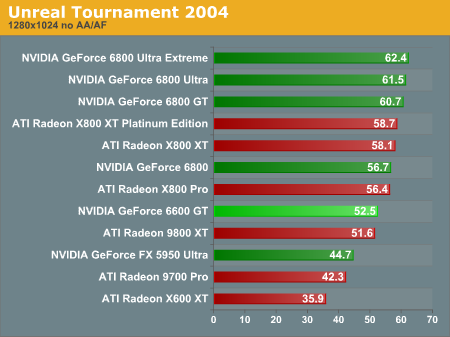



Final Words
It is clear that the 6600 GT hits a very sweet spot in the market. The card consistently performs on par with some of the lower end high end cards (6800 and X800 Pro) at lower resolutions below 1600x1200 without AA and AF enabled. This should be enough to sell any casual gamer on the card. Let alone the fact that even when AA and AF are turned on, the NV43 based GT is still a better option than the 5950 U and the 9800 XT in performance. Considering that these two previous gen cards go for at least $300 anywhere we could find them, this makes the 6600 GT a much better buy. On top of that, previous gen cards that go for $200 will be much less performing still. All this adds up to mean that even the hardcore gamer who just doesn't have $300 to $500 to spend will be very satisfied with a 6600 GT. If $200 is in the budget, and PCI Express is a necessity, the 6600 GT is absolutely the way to go.Unfortunately, at this point in time, those who want PCIe graphics are stuck buying only Intel based systems. AMD fairly consistently leads (in some cases utterly dominates) Intel in gaming performance. We are very reluctant to recommend building a PCI Express system intended for gaming until someone manages to launch a chipset with PCI Express support for AMD systems.
Hopefully, NVIDIA will crank out an AGP follow up their native PCIe solution at least as quickly as they did the reverse earlier this year.
Not wanting to let this review end on such a bittersweet note, we will say that we are very interested in getting down and dirty with some 6600 GT SLI benchmarks as soon as we can convince NVIDIA that they want to send us a connector. We have been very impressed with the 6600 GT, and we are excited about seeing what ATI has to offer for this market segment as well. With current generation coming to the mid range market segment, nobody looses.







